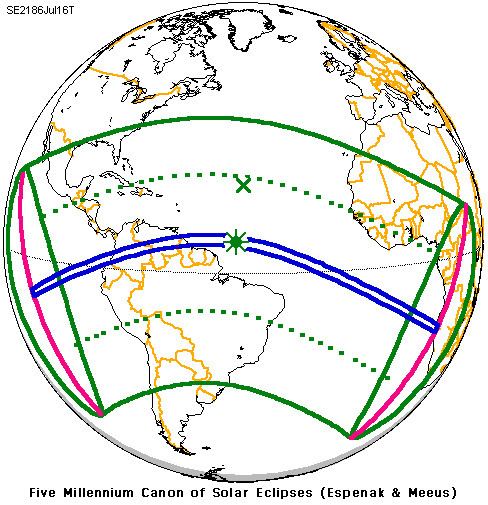Nature Total Magnitude 1.0805 Max. width of band 267 km (166 mi) Start date July 16, 2186 | Gamma -0.2396 Duration 449 sec (7 m 29 s) Greatest eclipse 15:14:54 | |
 | ||
There will be a solar eclipse on July 16, 2186, which will be the longest total eclipse for thousands of years. The eclipse will pass over the southern Galápagos Islands (with a total eclipse of 4 minutes occurring over the southern tip of Española Island), the northern tip of Ecuador (with a total eclipse of 3 minutes and 26 seconds on Isla Santa Rosa), central Colombia (4 minutes and 50 seconds over Bogota), central Venezuela, and northern Guyana (7 minutes and 4 seconds just north of Anna Regina).
Contents
Extreme duration
This will be the longest total solar eclipse between the dates of 4000 BC and at least AD 8000 (12,000 years), lasting a maximum of 7 minutes, 29 seconds. The factors that will make this such a long eclipse are:
The longest historical total eclipse lasted 7 minutes 28 seconds on June 15, 744BC. The longest eclipse theoretically possible for the 3rd millennium is 7 minutes and 32 seconds.
Saros 139
It is a part of saros series 139, repeating every 18 years, 11 days, containing 71 events. The series started with partial solar eclipse on May 17, 1501. It contains hybrid eclipses on August 11, 1627 through December 9, 1825 and total eclipses from December 21, 1843 through March 26, 2601. The series ends at member 71 as a partial eclipse on July 3, 2763. Members in the same column are one exeligmos apart and thus occur in the same geographic area.
The solar eclipse of June 13, 2132 will be the longest total solar eclipse since July 11, 1991 at 6 minutes, 55 seconds.
The longest duration of totality will be produced by member 39 at 7 minutes, 29 seconds on July 16, 2186. This is the longest solar eclipse computed between 4000BC and 6000AD.
